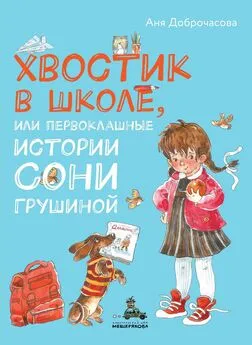Зази Тодд - Счастливый хвостик
- Название:Счастливый хвостик
- Автор:
- Жанр:
- Издательство:Манн, Иванов и Фербер
- Год:2021
- Город:Москва
- ISBN:9785001697305
- Рейтинг:
- Избранное:Добавить в избранное
-
Отзывы:
-
Ваша оценка:
Зази Тодд - Счастливый хвостик краткое содержание
Счастливый хвостик - читать онлайн бесплатно ознакомительный отрывок
Интервал:
Закладка:
Paul D. McGreevy, Joanne Righetti and Peter C. Thomson. “The reinforcing value of physical contact and the effect on canine heart rate of grooming in different anatomical areas,” Anthrozoös 18, no. 3 (2005): 236–244.
101
Franziska Kuhne, Johanna C. Hößler and Rainer Struwe. “Effects of human — dog familiarity on dogs’ behavioural responses to petting,” Applied Animal Behaviour Science 142, no. 3–4 (2012): 176–181.
102
Helen Vaterlaws-Whiteside and Amandine Hartmann. “Improving puppy behavior using a new standardized socialization program,” Applied Animal Behaviour Science 197 (2017): 55–61.
103
Franklin D. McMillan et al. “Differences in behavioral characteristics between dogs obtained as puppies from pet stores and those obtained from noncommercial breeders,” Journal of the American Veterinary Medical Association 242, no. 10 (2013): 1359–1363.
104
Paul D. McGreevy et al. “Dog behavior co-varies with height, body-weight and skull shape,” PLOS ONE 8, no. 12 (2013): e80529.
105
Todd W. Lue, Debbie P. Pantenburg and Phillip M. Crawford. “Impact of the owner-pet and client-veterinarian bond on the care that pets receive,” Journal of the American Veterinary Medical Association 232, no. 4 (2008): 531–540.
106
American Animal Hospital Association. “Frequency of veterinary visits,” 2014, aaha.org/professional/resources/frequency_of_veterinary_visits.aspx.
107
Zoe Belshaw et al. “Owners and veterinary surgeons in the United Kingdom disagree about what should happen during a small animal vaccination consultation,” Veterinary Sciences 5, no. 1 (2018): 7; Zoe Belshaw et al. “‘I always feel like I have to rush…’ Pet owner and small animal veterinary surgeons’ reflections on time during preventative healthcare consultations in the United Kingdom,” Veterinary Sciences 5, no. 1 (2018): 20.
108
Lawrence T. Glickman et al. “Evaluation of the risk of endocarditis and other cardiovascular events on the basis of the severity of periodontal disease in dogs,” Journal of the American Veterinary Medical Association 234, no. 4 (2009): 486–494; Lawrence T. Glickman et al. “Association between chronic azotemic kidney disease and the severity of periodontal disease in dogs,” Preventive Veterinary Medicine 99, no. 2–4 (2011): 193–200.
109
Steven E. Holmstrom et al. “2013 AAHA dental care guidelines for dogs and cats,” Journal of the American Animal Hospital Association 49, no. 2 (2013): 75–82.
110
Judith L. Stella, Amy E. Bauer and Candace C. Croney. “A cross-sectional study to estimate prevalence of periodontal disease in a population of dogs (Canis familiaris) in commercial breeding facilities in Indiana and Illinois,” PLOS ONE 13, no. 1 (2018): e0191395.
111
Marc Bekoff. “Social play behavior. Cooperation, fairness, trust, and the evolution of morality,” Journal of Consciousness Studies 8, no. 2 (2001): 81–90.
112
S.E. Byosiere, J. Espinosa and B. Smuts. “Investigating the function of play bows in adult pet dogs (Canis lupus familiaris),” Behavioural Processes 125 (2016):106–113.
113
Sarah-Elizabeth Byosiere et al. “Investigating the function of play bows in dog and wolf puppies (Canis lupus familiaris, Canis lupus occidentalis),” PLOS ONE 11, no. 12 (2016): e0168570.
114
Alexandra Horowitz. “Attention to attention in domestic dog (Canis familiaris) dyadic play,” Animal Cognition 12, no. 1 (2009): 107–118.
115
Marc Bekoff. “Play signals as punctuation: The structure of social play in canids,” Behaviour (1995): 419–429.
116
Rebecca Sommerville, Emily A. O’Connor and Lucy Asher. “Why do dogs play? Function and welfare implications of play in the domestic dog,” Applied Animal Behaviour Science 197 (2017): 1–8.
117
Marek Spinka, Ruth C. Newberry and Marc Bekoff. “Mammalian play: Training for the unexpected,” The Quarterly Review of Biology 76, no. 2 (2001): 141–168.
118
Zsuzsánna Horváth, Antal Dóka and Ádám Miklósi. “Affiliative and disciplinary behavior of human handlers during play with their dog affects cortisol concentrations in opposite directions,” Hormones and Behavior 54, no. 1 (2008): 107–114.
119
Lydia Ottenheimer Carrier et al. “Exploring the dog park: Relationships between social behaviours,sonality and cortisol in companion dogs,” Applied Animal Behaviour Science 146, no. 1–4 (2013): 96–106.
120
Melissa S. Howse, Rita E. Anderson and Carolyn J. Walsh. “Social behaviour of domestic dogs (Canis familiaris) in a public off-leash dog park,” Behavioural Processes 157 (2018): 691–701.
121
John Bradshaw and Nicola Rooney. “Dog social behavior and communication,” in The Domestic Dog: Its Evolution, Behavior and Interactions with People, ed. J. Serpell (Cambridge: Cambridge University Press, 2017), 133–159.
122
Neta-li Feuerstein and Joseph Terkel. “Interrelationships of dogs (Canis familiaris) and cats (Felis catus L.) living under the same roof,” Applied Animal Behaviour Science 113, no. 1–3 (2008): 150–165.
123
Jessica E. Thomson, Sophie S. Hall and Daniel S. Mills. “Evaluation of the relationship between cats and dogs living in the same home,” Journal of Veterinary Behavior 27 (2018): 35–40.
124
Michael W. Fox. “Behavioral effects of rearing dogs with cats during the ‘criticaliod of socialization,’” Behaviour 35, no. 3–4 (1969): 273–280.
125
Brian Hare and Michael Tomasello. “Human-like social skills in dogs?” Trends in Cognitive Sciences 9, no. 9 (2005): 439–444.
126
Juliane Kaminski, Andrea Pitsch and Michael Tomasello. “Dogs steal in the dark,” Animal Cognition 16, no. 3 (2013): 385–394; Juliane Bräuer et al. “Domestic dogs conceal auditory but not visual information from others,” Animal Cognition 16, no. 3 (2013): 351–359.
127
Charles H. Zeanah, Lisa J. Berlin and Neil W. Boris. “Practitioner review: Clinical applications of attachment theory and research for infants and young children,” Journal of Child Psychology and Psychiatry 52, no. 8 (2011): 819–833.
128
Elyssa Payne, Pauleen C. Bennett and Paul D. McGreevy. “Currentspectives on attachment and bonding in the dog — human dyad,” Psychology Research and Behavior Management 8 (2015): 71.
129
Márta Gácsi et al. “Human analogue safe haven effect of the owner: Behavioural and heart rate response to stressful social stimuli in dogs,” PLOS ONE 8, no. 3 (2013): e58475.
130
Isabella Merola, Emanuela Prato-Previde and Sarah Marshall-Pescini. “Social referencing in dog-owner dyads?” Animal Cognition 15, no. 2 (2012): 175–185.
131
Isabella Merola, Emanuela Prato-Previde and Sarah Marshall-Pescini. “Dogs’ social referencing towards owners and strangers,” PLOS ONE 7, no. 10 (2012): e47653.
132
Erica N. Feuerbacher and Clive D.L. Wynne. “Dogs don’t always prefer their owners and can quickly form strong preferences for certain strangers over others,” Journal of the Experimental Analysis of Behavior 108, no. 3 (2017): 305–317.
133
Gregory S. Berns, Andrew M. Brooks and Mark Spivak. “Scent of the familiar: An fMRI study of canine brain responses to familiar and unfamiliar human and dog odors,” Behavioural Processes 110 (2015): 37–46.
134
Peter F. Cook et al. “Awake canine fMRI predicts dogs’ preference for praise vs food,” Social Cognitive and Affective Neuroscience 11, no. 12 (2016): 1853–1862.
135
Deborah Custance and Jennifer Mayer. “Empathic-like responding by domestic dogs (Canis familiaris) to distress in humans: An exploratory study,” Animal Cognition 15, no. 5 (2012): 851–859.
136
Emily M. Sanford, Emma R. Burt and Julia E. Meyers-Manor. “Timmy’s in the well: Empathy and prosocial helping in dogs,” Learning & Behavior 46, no. 4 (2018): 374–386.
137
Natalia Albuquerque et al. “Dogs recognize dog and human emotions,” Biology Letters 12, no. 1 (2016): 20150883.
138
Hannah K. Worsley and Sean J. O’Hara. “Cross-species referential signalling events in domestic dogs (Canis familiaris),” Animal Cognition 21, no. 4 (2018): 457–465.
139
Nicola J. Rooney, John W.S. Bradshaw and Ian H. Robinson. “A comparison of dog — dog and dog — human play behaviour,” Applied Animal Behaviour Science 66, no. 3 (2000): 235–248.
140
Nicola J. Rooney, John W.S. Bradshaw and Ian H. Robinson. “Do dogs respond to play signals given by humans?” Animal Behaviour 61, no. 4 (2001): 715–722.
141
Alexandra Horowitz and Julie Hecht. “Examining dog — human play: The characteristics, affect, and vocalizations of a unique interspecific interaction,” Animal Cognition 19, no. 4 (2016): 779–788.
142
Tobey Ben-Aderet et al. “Dog-directed speech: Why do we use it and do dogs pay attention to it?” Proceedings of the Royal Society B 284, no. 1846 (2017): 20162429.
143
Sarah Jeannin et al. “Pet-directed speech draws adult dogs’ attention more efficiently than adult-directed speech,” Scientific Reports 7, no. 1 (2017): 4980.
144
Alex Benjamin and Katie Slocombe. “‘Who’s a good boy?!’ Dogs prefer naturalistic dog-directed speech,” Animal Cognition 21, no. 3 (2018): 353–364.
145
Carri Westgarth et al. “Pet ownership, dog types and attachment to pets in 9–10 year old children in Liverpool, UK,” BMC Veterinary Research 9, no. 1 (2013): 102.
146
Janine C. Muldoon, Joanne M. Williams and Alistair Lawrence. “‘Mum cleaned it and I just played with it’: Children’sceptions of their roles and responsibilities in the care of family pets,” Childhood 22, no. 2 (2015): 201–216.
147
Sophie S. Hall, Hannah F. Wright and Daniel S. Mills. “Parentceptions of the quality of life of pet dogs living with neuro-typically developing and neuro-atypically developing children: An exploratory study,” PLOS ONE 12, no. 9 (2017): e0185300.
148
Nathaniel J. Hall et al. “Behavioral and self-report measures influencing children’s reported attachment to their dog,” Anthrozoös 29, no. 1 (2016): 137–150.
149
American Veterinary Medical Association (AVMA). “Dog bite prevention,” Accessed March 31, 2018, avma.org/public/Pages/Dog-Bite-Prevention.aspx.
150
Ilana R. Reisner et al. “Behavioural characteristics associated with dog bites to children presenting to an urban trauma centre,” Injury Prevention 17, no. 5 (2011): 348–353.
Читать дальшеИнтервал:
Закладка:







![Хелен Тодд - Призрачные нити [≈ За пеленой северного тумана] [litres]](/books/1063953/helen-todd-prizrachnye-niti-za-pelenoj-severnogo.webp)


